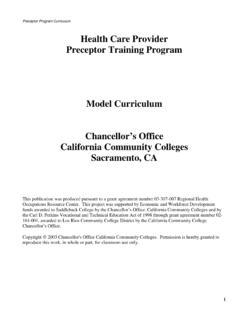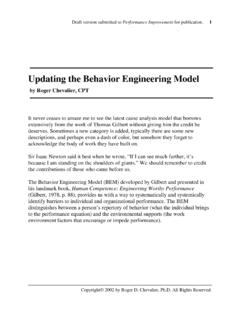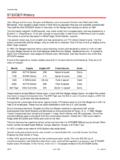Transcription of HERSEY-BLANCHARD SITUATIONAL LEADERSHIP …
1 MODULE 16 LEADERSHIP Update A leader lives in each of us MODULE GUIDE. Update What are some additional directions in LEADERSHIP development and research? The SITUATIONAL LEADERSHIP model focuses on the fit of LEADERSHIP style and follower maturity Leader-member exhange theory indicates that leaders develop special relationships with trusted followers What are some additional directions in LEADERSHIP development and research? / 1. Update What are some additional directions in LEADERSHIP development and research? THE SITUATIONAL LEADERSHIP model FOCUSES ON THE FIT. OF LEADERSHIP STYLE AND FOLLOWER MATURITY. In contrast to Fiedler's contingency LEADERSHIP model and its underlying assumption that LEADERSHIP style is hard to change, the HERSEY-BLANCHARD SITUATIONAL LEADERSHIP model suggests that successful leaders do adjust their styles.
2 For Hersey and Blanchard the key issue in making these adjustments is follower maturity, as indicated by their readiness to 1. perform in a given situation. Readiness, in this sense, is largely based on two major factors follower ability and follower confidence. The SITUATIONAL LEADERSHIP model views leaders as varying their emphasis on task and relationship behaviors to best deal with different levels of follower maturity. 2 The two- by-two matrix shown in the small figure indicates that four LEADERSHIP styles are possible. Delegating Style allowing the LEADERSHIP Styles in the HERSEY-BLANCHARD SITUATIONAL LEADERSHIP model group to take responsibility for task High decisions; this is a low-task, low- Participating Style Selling Style Share ideas Explain decisions Relationship Behaviors ------- ------- relationship style.
3 Followers able, Followers unable, unwilling, not confident willing, confident Participating Style . emphasizing shared ideas and Delegating Style Telling Style Turn over decisions Give instructions ------- ------- participative decisions on task Followers able, Followers unable, willing, confident unwilling, not confident Low directions; this is a low-task, high- Low High relationship style. Task Behaviors 2 / MODULE 16 (UPDATE) LEADERSHIP Selling Style explaining task directions in a supportive and persuasive way; this is a high- task, high-relationship style. Telling Style giving specific task directions and closely supervising work; this is a high- task, low-relationship style. Managers using the SITUATIONAL LEADERSHIP model must be able to implement the alternative LEADERSHIP styles as needed.
4 To do this, they have to understand the maturity of followers in terms of readiness for task performance and then use the style that best fits. In terms of the appropriate style-situation match ups, the SITUATIONAL LEADERSHIP model suggests the following. When follower maturity is high, the SITUATIONAL LEADERSHIP model calls for a delegating style which might be described as offering minimal LEADERSHIP intervention. The style is one of turning over decisions to followers who have high task readiness based on abilities, willingness and confidence about task accomplishment. When follower maturity is low, by contrast, the model calls for the telling style with its emphasis on task directed behaviors. The telling style works best in this situation of low readiness, by giving instructions and bringing structure to a situation where followers lack capability and are unwilling or insecure about their tasks.
5 The participating style is recommended for low-to-moderate readiness situations. Here, followers are capable but also unwilling or insecure about the tasks. As you might expect, this participation style with its emphasis on relationships is supposed to help followers share ideas and thus draw forth understanding and task confidence. The selling style is recommended for moderate to high-readiness situations. Here, followers lack capability but are willing or confident abouot the task. In this case, the selling style and its emphasis on task guidance is designed to facilitate performance through persuasive explanation. Hersey and Blanchard believe that leaders should be flexible and adjust their styles as followers and situations change over time.
6 The model also implies that if the correct styles are used in lower-readiness situations, followers will mature and grow in their abilities and What are some additional directions in LEADERSHIP development and research? / 3. confidence. This willingness to understand follower development and respond with flexibility allows the leader to become less directive as followers mature. The HERSEY-BLANCHARD SITUATIONAL LEADERSHIP model is intuitively appealing and has been widely used in management development programs. 3 Even though empirical research support has been limited, the conclusion seems to be that the basic ideas of the model have merit. Leaders might do well to consider altering styles to achieve the best fits with followers and situations, even as they change with time.
7 4 Also, the model reminds leaders that the skill levels and task confidence of followers should be given continuing attention through training and development efforts. 5. LEADER-MEMBER EXHANGE THEORY INDICATES THAT LEADERS. DEVELOP SPECIAL RELATIONSHIPS WITH TRUSTED FOLLOWERS. One of the things you may have noticed in your work and study groups is the tendencies of leaders to develop special relationships with some team members. This tendency is central to leader-member exchange theory, or LMX theory as it is often The theory basically recognizes that in most, or at least many, LEADERSHIP situations not everyone is treated the same by the leader. Instead, people fall into in groups and out groups in relationships with their leaders.
8 Obviously, the group you are in can have quite a significant influence on your experience with the leader. The notion underlying leader-member exchange theory is that as a leader and follower interact over time, their exchanges end up defining the follower's role. 7 Whether due to personality similarities or differences, time pressures and interaction opportunities, or the follower's competencies and accomplishments, this role ends up being defined into a high- exchange or low-exchange relationship with the leader. 4 / MODULE 16 (UPDATE) LEADERSHIP You might think of the LMX. concept in respect to a leader being Leader-Member Exchange Theory more willing to find time to spend Followers Followers relating to and interacting with some over time Leader- over time defined into Member defined into followers than others.
9 Those that do out-group Exchange in-group . Relationships get the leader's attention end up Perceptions of forming a special in-group Followers relationship with him or her. Compatibility Competency Look around, you're likely to Personality - + . see some example of this in classroom situations between instructors and certain students and in work situations between bosses and certain subordinates. And as you do consider this tendency, do you see any differences in the way in- and out-group members respond to differences in leader-member exchanges? One of the implications of the leader-member exchange theory is that the nature of the exchange is determined by the leader based on some presumed characteristics of the follower.
10 A high LMX relationship is usually based on perceived favorable personality, compatibility, and competency; a low LMX relationship is based on just the opposite set of views. For the follower in a high LMX relationship, being part of the leader's inner circle or in- group can have positive implications in terms of getting rewards, access to information, and other special treatments. Being in the out-group can have negative consequences on the same terms. For the leader, it is nice to be able to call on and depend upon the loyal support of those in the in-group. But the leader may also be missing out on lost opportunities of working more intensely with out-group members. Research on leader-member exchange theory places most value on its usefulness in describing leader-member The notions of high-LMX and low-LMX relationships What are some additional directions in LEADERSHIP development and research?







